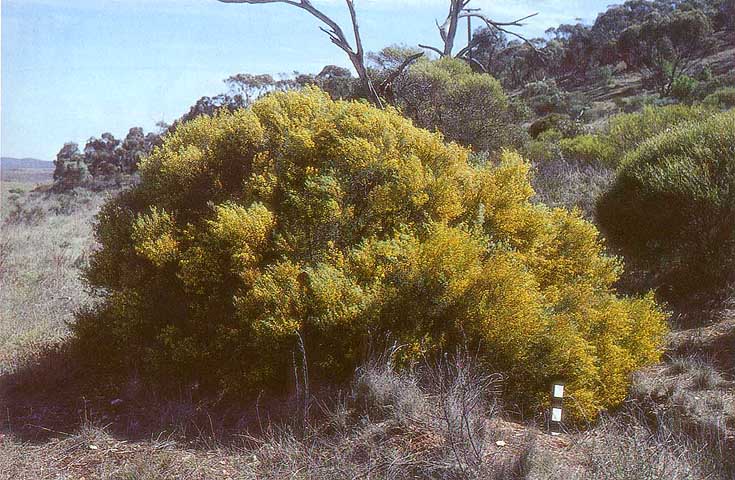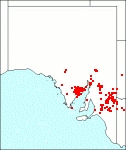Family: Fabaceae
Acacia wilhelmiana

Citation:
F. Mueller, Trans. Phil. Soc. Vic. 1:37 (1855), vide, A. B. Court, Muelleria 2 (3): 159 (1972).
Derivation: wilhelmiana—named in honour of Carl Wilhelmi, who collected around Port Lincoln, 1851-1854 and first discovered this plant.
Synonymy: Acacia bynoeana, Acacia calamifolia, Acacia leptophylla Common name: dwarf nealie
Description:
syn. A. bynoeana sens. Benth., Fl.Aust. 2:337 (1864), atque auctt, cum subseq, non quoad Benth. (1855). A. bynoeana Benth. var. latifolia J. M. Black, Fl.S. Aust. ed. 2, 2:418 (1948). A. calamifolia var. wilhelmiana(F. Muell.)Benth. Fl. Austral. 2:339~(1864).
Dense compact, rounded spreading, viscid shrubs 1-3 m high; branches almost terete, puberulous, more or less farinaceous, tuberculate especially on the younger branchlets and marked with prominent raised phyllode bases.
Phyllodes linear, oblong-cuneate, 1-3 cm long 1-4 mm broad, flat or subterete, shallowly sigmoid, usually viscid, sometimes farinaceous, glabrous, 2-5 longitudinal veins on each face sometimes covered with minute whitish scales, apex thick and obtuse or with a short hard oblique point.
Inflorescences axillary and solitary or twin, sometimes on a very short common peduncle; Flower-heads globular, yellow, c. 20-flowered; peduncles c. 2-8 mm long, golden pubescent; flowers 5-merous.
Legumes linear, 3-6 cm long, 2-3 mm broad, curved to circinate, twisted, stipitate, viscid when young, brown, margins thick yellowish not or scarcely contracted between seeds. Seeds longitudinal in legume obloid; funicle filiform, with 2-3 short folds below the large aril.
|
|
Distribution:
|
Rather common from Eyre Peninsula eastwards to the Flinders Ranges, Northern Lofty and Murray regions to Victoria. Mainly in open scrub formation with Eucalyptus socialis, and E. gracilis or with E. incrassata and Melaleuca uncinata. Soils; mainly hard alkaline red duplex, brown calcareous earths or grey-brown calcareous loamy earths. Rainfall 200-400 mm. Also N.S.W and Vic.
S.Aust.: GT, FR, EA, EP, NL, MU, YP, SL.
|
Flowering time: August — October.
|

SA Distribution Map based
on current data relating to
specimens held in the
State Herbarium of South Australia
|
Biology:
No text
Related taxa:
Refer to Acacia menzelii (sp. 69), A. montana (sp. 65), A. sclerophylla (sp. 76), A. pinguifolia (sp. 80), A. farinosa (sp. 79) for distinguishing features. A. barattensis (sp. 70) differs from all the above species in having 4-merous flowers.
Taxonomic notes:
Court (1972) deals at length with the nomenclatural confusion of the name A. wilhelmiana in particular with A. bynoeana. There is considerable variation in the phyllodes of this species which may vary from broad and flat to subterete. The specimens with broad phyllodes may resemble A. montana.
Cultivation:
A small, compact, shrub suitable for cultivation as a low shelter belt species in the dry inland areas. Medium growth rate.
Author:
Not yet available
Source:

|

